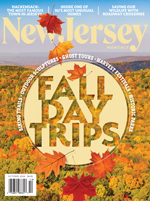
Illustration by Alessandro Gottardo
On a recent night at his Saddle River Inn, chef Jamie Knott received some boneless Wagyu sirloins from his butcher. “It was a new product,” he says, “and I got excited.” In the past, he would have had to edit and reprint the specials menu off-site, ”a cumbersome task” that would have cost him time as well as money.
Instead, having switched to a digital menu that customers can read on their phones, “it was on in 30 seconds.” The Wagyu replaced another steak on the specials menu that he was almost out of. A side benefit of the digital update was that it avoided disappointing any guests who might have wanted that suddenly unavailable item.
The technology that enables the instant update is called QR, short for Quick Response, a code developed in 1994. Customers open the camera on a smartphone or other device, and focus on the QR pattern, which brings up a link to the current menu.
“There’s definitely been a spike in the use of QR menus this year,” says Jay Winkler, chief creative officer at Idea Lab Digital in Moorestown, which has helped a number of restaurants and small businesses in South Jersey switch to QR. “Patrons are becoming much more comfortable with accessing menus from their phones.” In these pandemic times, he notes, another benefit is that digital menus are essentially touchless. It’s just you and your phone.
The cost of going digital, according to Winkler, can range from $1,800 to $18,000, depending on the complexity of the system. Knott says his switch to QR cost a mere $500. (“It’s just an app you download,” he says.) That means it will quickly pay for itself. “I don’t have to buy 500 or 1,000 pieces of paper that were a dollar apiece,” he explains. “Plus, when you have the ability to create no waste, it should be a no-brainer.”
When Saddle River Inn introduced the QR codes last September, Knott says, some older customers did not quite get how they worked. He gladly provided paper menus and still does on request. But within a few months, only one or two diners were asking for a paper menu.
As an expedience early in the pandemic, Bob Hochgertel, managing director of Kings Road Brewery in Haddonfield, posted the daily beer list in the brewery’s front window in the form of QR codes, allowing patrons to scan it without entering the taproom. What he thought would be temporary caught on. Though he continues to offer paper menus, Hochgertel says he has been saving money on printing. “As people become more accustomed to using them,” he predicts, “the use of the codes will continue to grow.”
Back in 2014, when Chris Cannon opened Jockey Hollow Bar & Kitchen in Morristown, he put his menus on iPads. “People just freaked out, saying, ‘Where’s my menu?’ and ‘This is ridiculous!’” he recalls. Cannon retained the iPads for the rotating wine lists, but returned the food menu to paper.
Over time, as his customers became acclimated, he reduced the number of paper menus he printed to only about 10 a day. “At this point, it’s easy for people,” he says. “We’ll be paper-free going forward.”
Looking at the repercussions from the other end of the telescope, the move to digital has the capacity to hurt local printing companies. That’s why Porta in Asbury Park decided not to go digital. Assistant general manager Gianna Skurzynski says it was an easy decision to do one-time throwaway menus at Porta.
“We preferred to spend a little extra money, or the same amount we were spending on menus, to keep a local print shop in business,” Skurzynski says. With three menus (brunch, lunch, dinner), Porta orders about 600 sheets from Knockout Graphics in Asbury Park each week.
The pandemic spurred what Winkler calls “a paradigm shift that people have become comfortable with.” But he wonders whether a desire for the old and familiar will resume as the health crisis wanes.
[RELATED: The High-Tech Nostalgia of Automat Kitchen]
For Audrey Winzinger, marketing manager of Robin’s Nest in Mount Holly, paper is toast. Noticing that her Covid-conscious customers, concerned about sanitation, were hesitant to touch physical menus, she made the investment.
“We would have never gone the digital route before this,” she says, “but now, I don’t think we’ll ever go back.”



